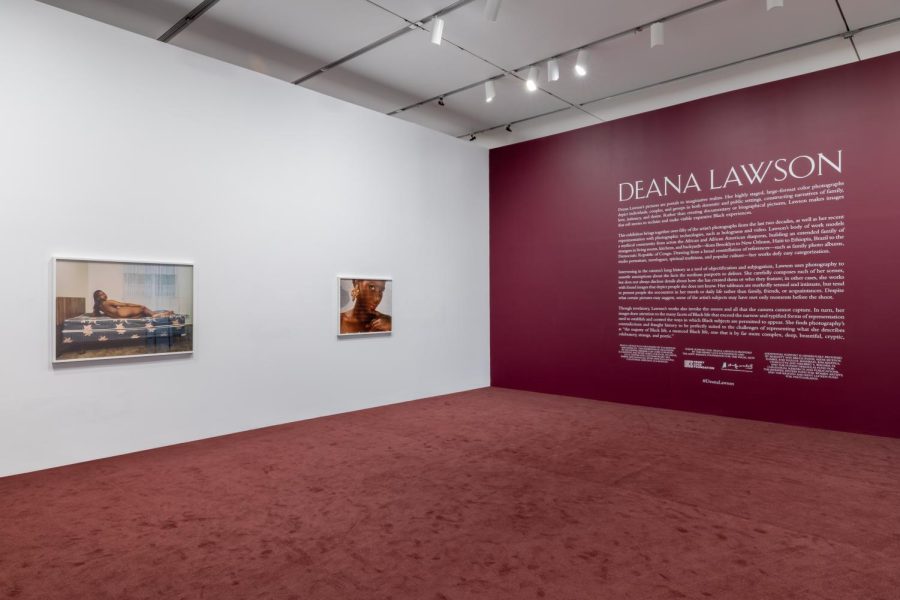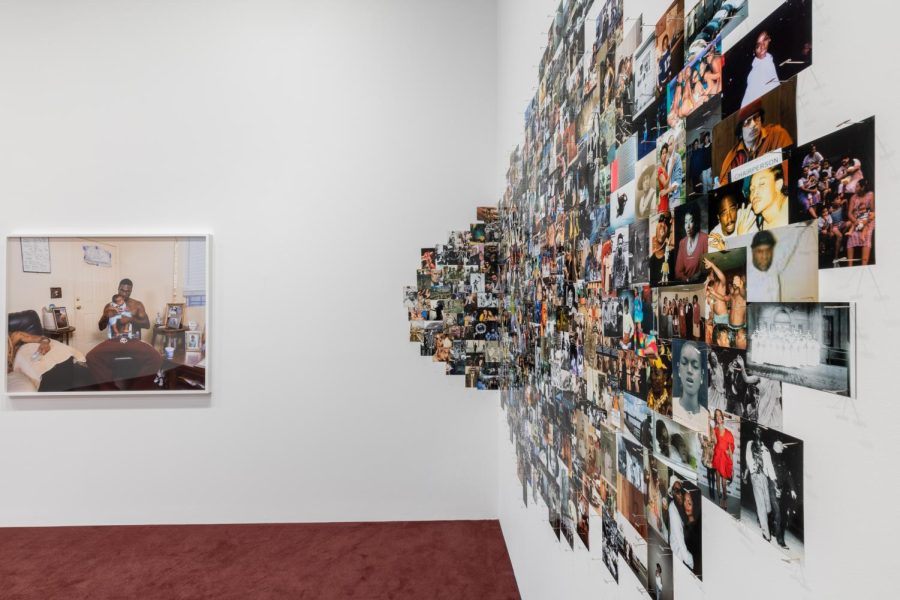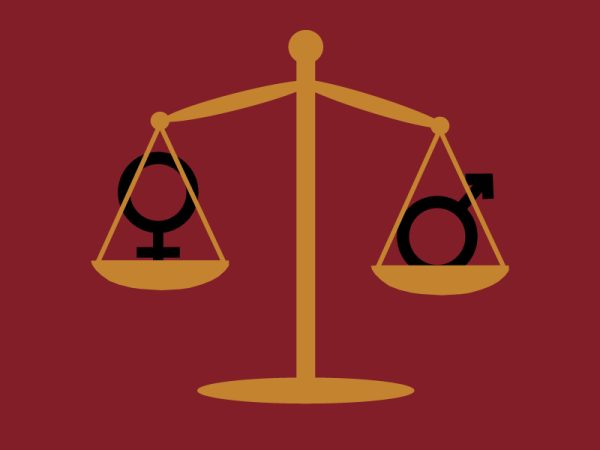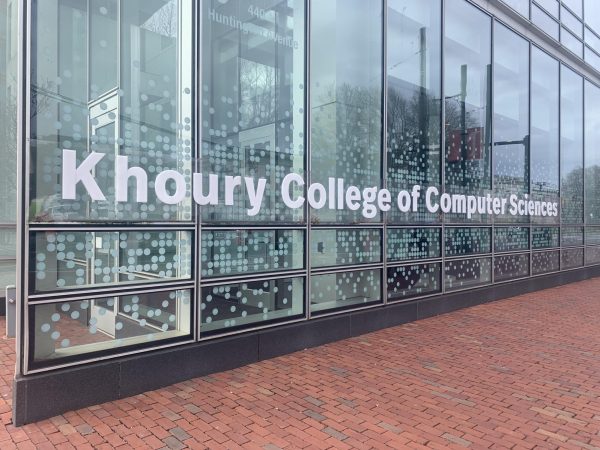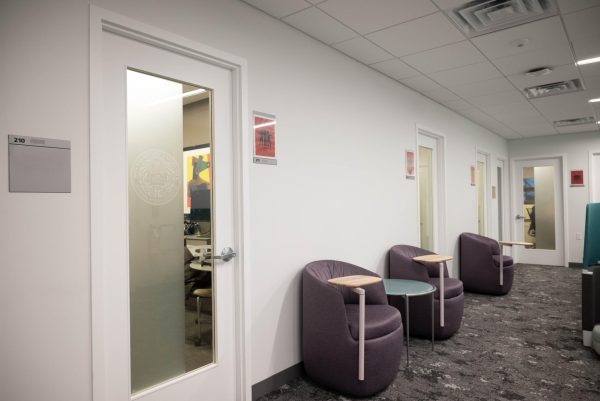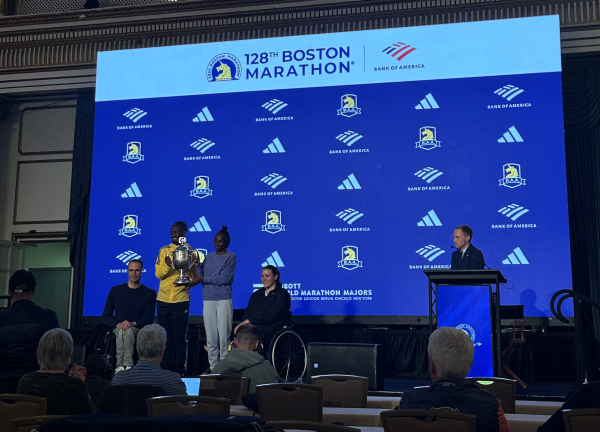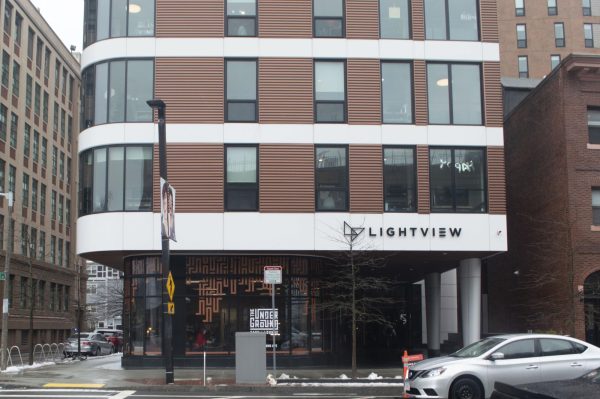ICA exhibition celebrates Black life, culture through photography
Artist Deana Lawson’s self-titled exhibition at the Institute of Contemporary Art primarily presents her large-scale color photographs. Installation view, Deana Lawson, The Institute of Contemporary Art/Boston, 2021. Photo credit to Mel Taing.
February 9, 2022
The floor of artist Deana Lawson’s exhibition at the Institute of Contemporary Art is covered with a soft, merlot-colored carpet to emulate the comfortable feeling of being at home. And, visitors are expected to engage with her photographs on an intimate level.
The self-titled exhibition primarily presents Lawson’s large-scale color photographs, including staged tableaux, studio portraits, family albums and documentary images. Viewers will see Black lives and experiences through her eyes, framing them as “beautiful, powerful and intelligent,” according to the website.
Anni Pullagura, a curatorial assistant at the ICA who worked with museum curators Eva Respini and Peter Eleey to put together Lawson’s exhibition, said Lawson’s vision was to create “portals to imaginary realms” through her work.
“There’s this idea of photography that images, visual culture can [take us] to another space, whether it’s imagined, whether it’s fictional, whether it’s rooted in truth, or biography, or the ways that we see the world,” Pullagura said.
Pullagura said common threads that are present in Lawson’s work include strong gazes from the people photographed being returned to the viewer; rich purples, blues and reds; “gorgeous skin tones” and strategic placement of props in environments surrounding her subjects.
The level of detail in each photograph allows viewers to see Lawson’s expert technical photography skills. For Pullagura, who had seen Lawson’s work prior to curating the exhibition, there is something new that catches her eye and prompts a different question.
“I think she’s an artist who really requires the viewers to ask questions of themselves, [and] ask questions of the work,” Pullagura said. “She doesn’t provide answers, so there’s a lot of trust there.”
As part of her creative process, Lawson staged and snapped photos of Black individuals and groups in public and private settings. Over 50 of Lawson’s works in the exhibition encourage viewers to reflect on their interpretation of her photographs and artworks.
“It’s not a single subject exhibition,” Pullagura said. “So there’s not a specific theme that they’re looking at, there’s not a subject or organizing around. The subject itself is the artist.”
Beyond photographs, Lawson also works with other mediums, such as holograms, layered images and videos in her exhibition. In the corners of some galleries, crystals are placed on the carpeted floor as a symbolism of healing and restoring energies, as well as positivity, peace and focus.
Gloria Sutton, a Northeastern University associate professor who teaches contemporary art history, said the size of Lawson’s artworks and “refusal to adhere to convention” tells a powerful narrative in her exhibition, in addition to the mediums Lawson chose.
“As an artist, she’s pushing our expectations for photographic work, not just to be about images and surfaces,” Sutton said. “This exhibition is a really good example [of] how Deana is pushing the convention of photography by including these assemblages or collages, how she’s using video and projection in that space and even down to incorporating crystals in the space speaks to the way in which the photographs are part of a bigger exhibition framework that Deana’s interested in pushing.”
With Lawson’s photography as the main medium presented in the exhibition, she presents her subjects to a range of emotions and lived experiences.
“One of the ways that I think she really pushes the boundaries of her medium is she thinks of photography as a tool to be able to tell different types of stories and how those stories manifest in spaces can happen really differently depending on the object or the relationship that’s being depicted,” Pullagura said.
While mediums affect the viewer’s experience, the people working behind the scenes in museums are also an important aspect in curating artworks. Sutton said it is important to look for diverse representations in the artists and people displayed on museum walls and those in curatorial departments.
“We see these as monolithic institutions, but they’re made up of individuals making choices on a daily basis,” Sutton said. “It does matter if we have more diversity and exposure and experience in the curatorial departments in equal measure as we see in terms of the work on the walls.”
In the grander context of art consumers and critics, Sutton encourages viewers to consider and address the “blind spots and biases and omissions” in museums.
“In fact, it’s the responsibility of all art historians to be equally invested in examining these questions around bias, omission and representation, not just scholars of color,” Sutton said.
Sutton facilitated virtual discussions with Respini, one of the curators, on Lawson’s art in the past. For Sutton, the staged images act as a reminder that everything that surrounds the viewer is also carefully constructed.
“I think the other thing that comes across in that show is just studied rigor that comes through her images that capture a ton of information,” Sutton said. “Even though some of them may look like snapshots, like they’re blurred, or there’s a kind of flash glare, everything in that image is composed [and] organized.”
Although Lawson has been an artist for over 20 years, Pullagura explained that this exhibition is Lawson’s first survey exhibition.
“[A survey exhibition is] a chance to really look back, take pause, take stock of the work that she’s produced and present an image of her career and progress in practice to date,” Pullagura said. “The pictures that you see in her exhibition range from her earliest work in 2004 to her most recent work at the time when the exhibition opened last year in November in 2021.”
Pullagura said there is a “sense of closeness” in Lawson’s work that pulls viewers in.
“I hope that when visitors see the exhibition … they really feel that they’re being transported, that they are entering these images and having a dialogue with the works that are on view, the subjects that are depicted and with Deana herself when she’s seen through the work that she presents to us in the space,” Pullagura said.
Kate Smails, a visitor assistant, has been working at the museum for a month. She said the striking photographs in the exhibition capture the intricate essence of Black stories.
“I just like the celebratory aspect of it, the way that the Black community can be represented so beautifully … and so glaring at the cameras, at times calling you out, making you look into their eyes,” Smails said. “They’re not just the subjects or like the objects but they also have command of the viewer in a really cool way.”
Smails is particularly drawn to Lawson’s 2018 work “Nation,” a pigment print and collaged photograph showcasing two men sitting on a brown leather couch. One of the men holds a silver iPhone in one hand and mimics a finger gun, revealing only his eyes. The other has a golden dental apparatus that functions as a mouthpiece. Lawson drew inspiration from George Washington’s dentures that had the teeth of slaves.
“It’s not just pictures of people doing things. They are meant to represent more than just what they’re doing,” Smails said.
The exhibition is on view on the fourth floor of the ICA until Feb. 27. Northeastern students can enter for free. The museum offers free admission Thursdays after 5 p.m. for other visitors.


